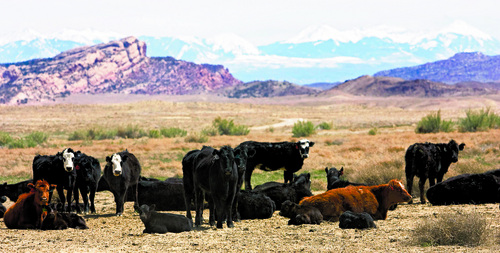This is an archived article that was published on sltrib.com in 2014, and information in the article may be outdated. It is provided only for personal research purposes and may not be reprinted.
Livestock grazing has been a part of the western landscape of the United States since settlers arrived.
The first recorded livestock policy, according to the U.S. Forest Service, was published in 1905 when the agency was created by Congress. Further and more defined regulation of livestock grazing came in 1934 via the Taylor Grazing Act.
Who sells grazing permits?
Most grazing permits are handled by the U.S. Forest Service and the Bureau of Land Management (BLM). Permits can also be sold on private and state lands, including lands owned by the Utah School and Institutional Trust Lands Administration (SITLA).
Land managers determine the amount of available forage in an area and then sell what they determine are an appropriate number of permits.
What do permits cost?
Ranchers are often frustrated when critics of the grazing program use one number — $1.35 — to argue it's cheap to run cattle on federal lands. That number is the beginning point for the formula that dictates the actual bill.
The $1.35 fee is applied to an "Animal Unit Month" or AUM — the approximate amount of forage a 1,000-pound cow with a calf will eat in one month.
Ranchers are charged based on the number of AUMs they use and how many months they use them.
For instance, if a rancher has 1,000 AUMs and runs cattle on federal lands for four months, the fee is $5,400.
Longer-term grazing permit holders are expected to make and maintain improvements on the land, primarily water developments and fencing.
Those not using fencing, particularly those running sheep, are expected to patrol their herds and keep them on the proper allotment. Moving the animals from summer to winter range is costly, and livestock lost to predators can reduce potential profits.
Randy Parker, chief executive office of the Utah Farm Bureau, says the $1.35 figure is a "misnomer."
"There are many additional costs. Some years [ranchers] might be in good shape and other years they get beat up pretty good," Parker said. "They are hard working, they love the land and they love to work the crops or livestock. They also do a lot to help the land and the wildlife they share it with."
Environmental groups argue grazing damages ecosystems and endangers other species, and have called for restrictions and increased fees.
A 2005 Government Accountability Office report found that the BLM and the Forest Service would have to charge an AUM fee several times higher than the $1.35 to recover their expenditures. The Obama administration rejected a proposed overhaul in 2011, the New York Times reported.
More recently, advocates for wild horses have argued grazing livestock, not an overpopulation of wild horses, are more damaging to the drought-stricken western range, contending the horses are being unfairly used as a scapegoat.
Are all grazing permits based on the $1.35 fee?
SITLA is charging $4.78 per AUM for certain areas and $8.32 per AUM on select allotments. So the same rancher with 1,000 AUMs would pay $19,120 for four months.
Terry Padilla, Intermountain Region range director for the U.S. Forest Service out of Ogden, said current private AUM fees run between $11 and $12.
The current $1.35 federal grazing fee, according to the BLM, is applied to federal lands managed by the BLM and Forest Service in 16 western states.
The fee is adjusted each year using a formula involving private grazing land rates, cattle prices and the cost of livestock production. The grazing fee drops when the prices are low and increases when appropriate. It can't drop below $1.35, due to a 1986 executive order.
Is grazing on public lands increasing?
The BLM reports there has been a gradual decrease in livestock grazing over the years.
"Grazing use on public lands has declined from 18.2 million AUMs in 1954 to 7.9 million AUMs in 2013," according to a BLM fact sheet.
Parker said Utah's numbers for livestock on public lands have also declined since the 1940s, when 5.5 million AUMs were allocated. In 2012, Parker said, that number was about 1.3 million.
Twitter: @BrettPrettyman



